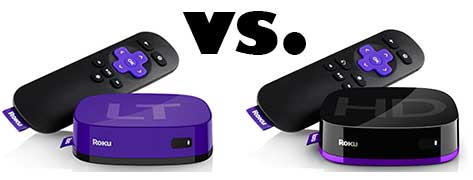At first glance, these two devices are very, very similar. They have similar performance capabilities, they both have the same video output options, and they both offer access to the same selection of Roku channels. But the Roku LT is less expensive than the Roku HD, so continue reading below to see which device offers the best value for your money. From the chart above, you can see that the only difference in these categories is the inclusion of an instant replay button on the Roku HD remote control.
Some Roku LT Advantages
Both devices offer similar performance owing to their very similar processors, and both devices feature the one-stop search feature when they have downloaded and installed the available Roku updates.
Some Roku HD Advantages
The biggest advantage that I can see of the Roku HD vs. the Roku LT is simply the difference in color. While the LT is very small and can be hidden relatively well in your home theater setup, it still requires a line of sight for the remote control. So you are going to wind up with a bright purple box that will likely contrast with the common black, brown or tan colors usually found in home theater setups. The Roku HD also has an instant replay function on its’ remote control, which allows you to skip back approximately seven seconds each time that it is pressed. You can do this many times, allowing for a simpler rewind procedure than that offered by the Roku’s dedicated rewind button. The Roku HD benefits from drawing less power and being slightly lighter than the Roku LT, but the differences in both of these areas are minimal.
Conclusion
These are two very similar devices, with a very similar price point. If you are OK with the purple color of the Roku LT, then its’ lower price is a good reason to select it over the comparable Roku HD. The improvements offered on the Roku HD over the Roku LT are very minimal and, in my opinion, not worth the added cost. But the purple color sticks out like a sore thumb in a lot of home entertainment setups, making the more neutral black color of the Roku HD more visually appealing. If you aren’t planning to connect your Roku to an older TV with the included composite cables, then you will need an HDMI cable. The HDMI cable will also allow you to view 720p content on your HDTV, while the composite cables are only capable of transmitting 480p content. You can read our comparison of the Roku 3 vs. the Roku 2 XD here. Read a comparison of the Roku HD and the Roku 3. After receiving his Bachelor’s and Master’s degrees in Computer Science he spent several years working in IT management for small businesses. However, he now works full time writing content online and creating websites. His main writing topics include iPhones, Microsoft Office, Google Apps, Android, and Photoshop, but he has also written about many other tech topics as well. Read his full bio here.
You may opt out at any time. Read our Privacy Policy













